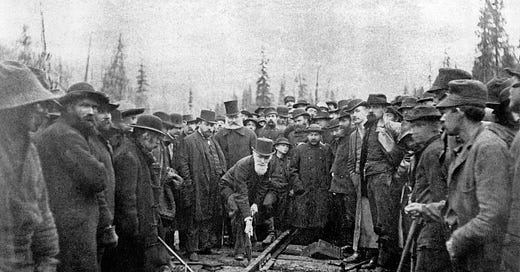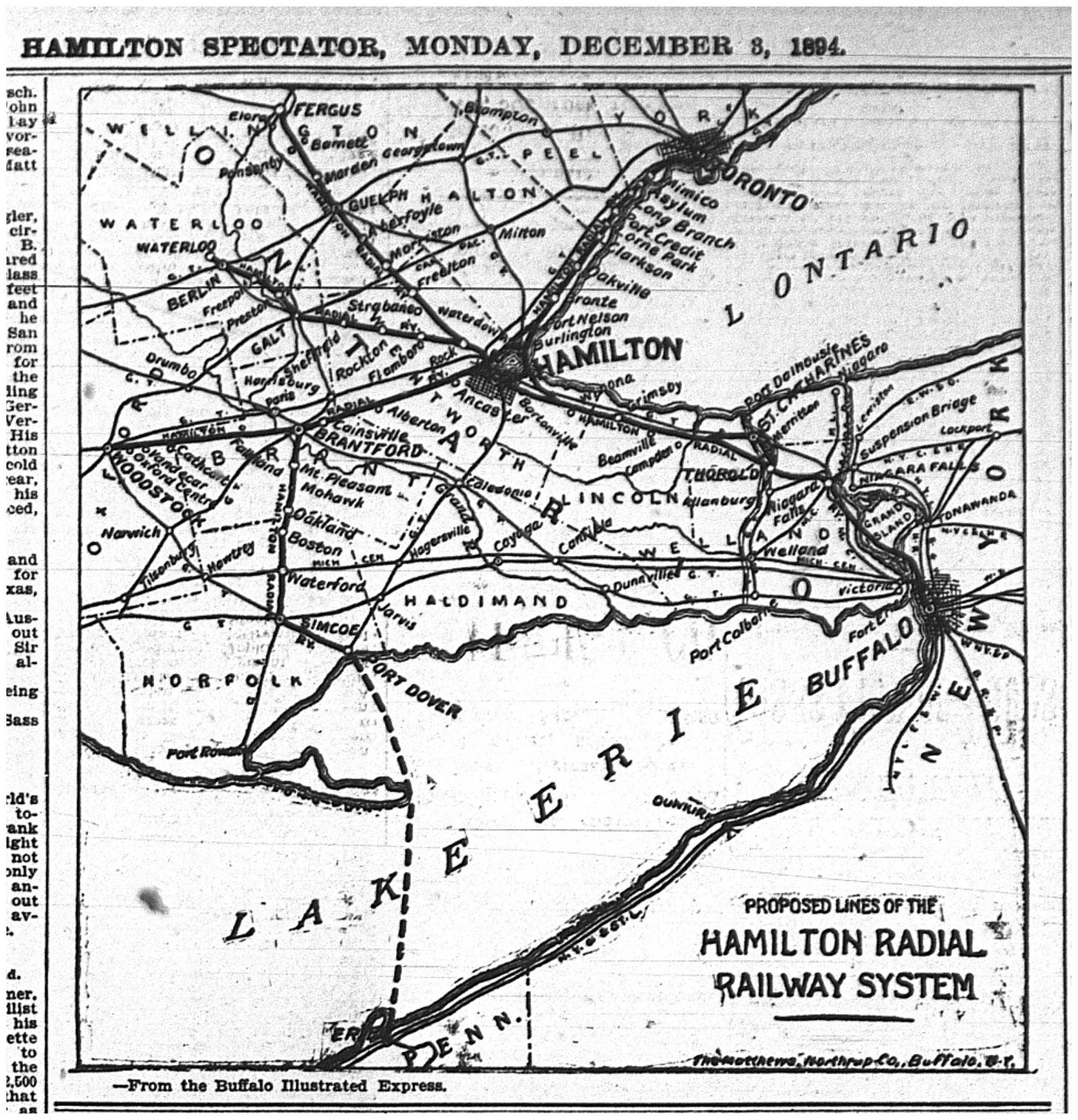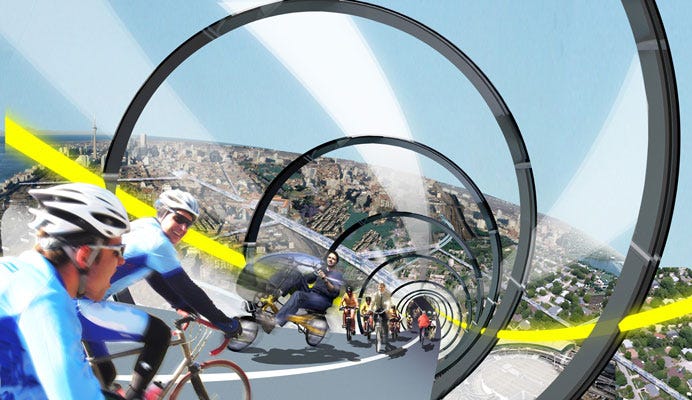150 years ago, Canada built a railway to stop American expansion north.
In these troubled times, we should dream and think big again.
This morning it appears that the 25% tariff on aluminum and steel is on top of the proposed 25% tariff on all Canadian goods. The threats keep getting worse.
In 1871, the Prime Minister of Canada, John A. McDonald, promised British Columbia a railway connecting it to the east if it joined Canada. In 1880 the work started in earnest. It was not easy, and the route chosen was particularly difficult. According to Michael Ledger-Lomas in Engelsberg Ideas:
The origins of the CPR were strategic rather than economic: it was meant to protect British North America against the United States… Macdonald could hardly fail to notice that it had emerged from the Civil War as an industrial and military hegemon, whose leaders often ruminated aloud about which bits of British territory to annex and when. Macdonald came to feel that only confederating the United Province of Canada with other British colonies could persuade the Americans – not to mention the British – to take their independence seriously.
He picked a difficult route close to the border to cut off American expansion.
The first surveyors thought it should veer north-west after leaving Winnipeg to pass through the rich soils which might attract settlers and generate profitable rail traffic. It would then follow a wagon route to the Pacific, crossing the Rockies at the Yellowhead Pass. Yet the final route struck much further south, hugging the northern shore of Lake Superior before cutting across the southern Canadian prairies. It was an attempt to forestall American penetration of those regions which involved compromises and huge gambles.
The gambles paid off, and on 4 July 1886, the first train from Montreal pulled into Vancouver.
Today, American leaders are again ruminating about annexing Canada, and have destroyed the trust that had been built up over the years. That’s why when it comes to transportation, Canadians have to make some compromises and huge gambles again.
The first step should be to invest in major rail infrastructure again. The federal government is already “seriously considering” a high-speed rail link between Québec City and Toronto, heading from Ottawa via Peterborough rather than south from Ottawa through Kingston. This is interesting for a number of reasons, and as Macleans Magazine noted, it could help ameliorate our housing crisis- people could live in London or Peterborough and commute by rail. It could be a giant real estate play like it was in 1880- Pierre Berton “pinpointed the CPR as the origin of Canada’s addiction to real-estate speculation, with the magic power to make Winnipeg as expensive as Chicago or to convince people to move to Edmonton.”
The next step should be to bring back systems like The Hamilton Radial Electric Railway and expand them through the entire Golden Horseshoe. In 1906 you could take a streetcar from Buffalo to Toronto or Guelph and just about any town along the way. It all ran on the energy from Niagara Falls.
Like so many electric rail systems, it was put out of business by the gasoline powered automobile.
Today, many politicians are obsessed with the automobile; Doug Ford in Ontario has killed license fees, frozen or reduced gas taxes, is spending billions on new highways and on burying streetcar lines so that they don’t get in the way of cars. He is running for office with the promise of building an astronomically expensive car tunnel under Toronto. He is ripping up bike lanes and making it difficult to build new ones because he wants the room for cars. (see How car-brained is Doug Ford's Ontario Government?)
Meanwhile, these cars run on American gasoline and are built by American companies that will probably be reshoring their manufacturing south of the border to placate the American president.
Ford thinks very much like his former buddy Donald Trump, who interferes in city politics and wants to rip up bike lanes, “one of the biggest contributing factors to traffic congestion in the first place.” Ford calls himself Captain Canada but he is still really Captain Trump Lite.
It might be more appropriate to stop planning our cities around cars, and to bring back the streetcar suburb, building communities stretched along the high-speed rail lines and rebuilt radial electric railways- a hundred years ago you could take the Yonge streetcar all the way to Lake Simcoe.
We have seen this movie before; in 1866 the USA abrogated the Reciprocity Treaty with Canada and imposed tariffs of 40% as part of a protectionist trade policy designed to support domestic industries. According to wikipedia,
“High U.S. tariffs, particularly on manufactured goods like iron, steel, and textiles, limited imports and reduced trade volumes with key trading partners. This protectionist stance often frustrated countries that relied on exporting goods to the United States, potentially straining diplomatic and economic ties.”
John A. McDonald retaliated, and other politicians supported him: “In 1876 he endorsed Macdonald’s and Tupper’s views of what would become the National Policy: if the Americans were determined to keep Canadian products out of American markets, then Canada should restrict American access to Canadian markets.” It would remain the basis of Canadian economic development for another century.
We’ve had our look at free trade since Brian Mulroney and Ronald Reagan signed NAFTA in 1988. Today, a lot of Canadians find that there is no work and no money, and it appears that the American government is abrogating its treaties again. We need a new National Policy.
With transportation, we need a policy which reduces our dependence on American gas, oil and motor vehicles. Let’s invest in high speed rail, transit, bikes, in Goldilocks Density housing and walkable communities. Let’s electrify everything with wind, water, and CANDU reactors.
We don’t need car tunnels under the 401 highway; we could build Chris Hardwicke’s bike tunnels in the sky. We can stand on our own and think big.
I miss comments and am turning them back on. But these are difficult times and if this turns into a name-calling cross-border skirmish I am going to use the “delete comment” button more often.













Alan Kandel wrote: "...it is my firm belief that it is to the passenger-train commuting public's benefit to keep freight and passenger train tracks separate."
I go a few stages further:
(1) Double-track all the current rail lines and use them only for freight traffic.
(2) Until that is done, tell (don't ask) CP and CN to cooperate in places like the Fraser Canyon to create two one-way lines capable of increasing traffic flow between the prairies and the coastal ports.
(3) Electrify these lines to eliminate diesel usage (and possible dependence on American oil refiners of Canadian oil) and use Canadian hydro- or fossil-fueled (ugh!) electricity.
(4) Further develop geothermal electricity generation using Canadian technology such as Eavor.
(5) Recreate the trans-Canadian passenger rail system from Vancouver to Halifax using European high-speed rail technology.
(6) Ensure all HSR stations connect to local urban transit systems; if necessary, build those new (electric) transit systems.
(7) And so much more...
An American here, hoping Canadians do everything possible to benefit themselves and help us bury Donald Trump and his oligarchs!